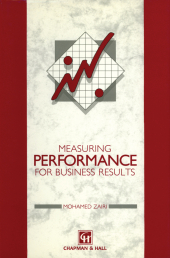 Neuerscheinungen 2012Stand: 2020-01-07 |
Schnellsuche
ISBN/Stichwort/Autor
|
Herderstraße 10
10625 Berlin
Tel.: 030 315 714 16
Fax 030 315 714 14
info@buchspektrum.de |

Mohamed Zairi
Measuring Performance for Business Results
Softcover reprint of the original 1st ed. 1994. 2012. xix, 310 S. XIX, 310 p. 235 mm
Verlag/Jahr: SPRINGER NETHERLANDS; SPRINGER, BERLIN 2012
ISBN: 9401045682 (9401045682)
Neue ISBN: 978-9401045681 (9789401045681)
Preis und Lieferzeit: Bitte klicken
Financial measures have traditionally been the cornerstone of the perform ance measurement system. In recent years, there has been a shift from treating financial figures as the foundation for performance measurement to treating them as one among a broader set of potential financial measures. Changes in cost structures and the manufacturing and competi tive environment have been responsible for the change of emphasis. In today´s worldwide competitive environment companies are compet ing in terms of product quality, delivery, reliability, after-sales service and customer satisfaction. None of these variables are measured by traditional financial measures, despite the fact that they represent the major goals of world-class manufacturing companies. By focusing mainly on financial variables there is a danger that the performance reporting system will motivate managers to focus exclusively on cost reduction and short-term profitability and ignore many of the critical factors that determine long-term business success. The key to success, in today´s global economy, is total customer satisfaction. To achieve this, companies must develop performance measures that drive employees to control processes that satisfy customer expectations. In particular, performance measures should provide process-level information that motivates employees to achieve the responsiveness and flexibility that companies require to compete on a global basis. Responsiveness is achieved by building relationships that lead to satisfied customers, suppliers and employees. Flexibility is achieved by reducing output variation in proceSfes; for example, the reduction of lead times and delays are both necessary for sustained competitive excellence and long-term profitability.
Part 1. Introduction. The meaning of performance measurement systems in a quality context. Measuring total quality performance in all functions. The strategic management of quality: negative vs positive quality. Measurement for total customer satisfaction: the role of quality function deployment (QFD). Measuring for competitiveness: the role of benchmarking. Measurement for quality culture: the role of self-assessment tools. Performance improvement through performance appraisal. Quality policy deployment: the key driver for performance measurement. Implementing effective performance measurement systems. Linking performance measurement to bottom line results: where is the evidence? Part 2. Case studies in performance measurement. Florida Power and Light. Philips Taiwan. Motorola. IBM Rochester. Rank Xerox Corporation. Federal Express. Cadillac Motor Company. Milliken& Co. Wallace Co. Global Metallurgical Inc. Marlow Industries Inc. Solectron. Zytech Co. Granite Rock Co. Ritz-Carlton Hotel Co. Texas Instruments: Rank Xerox Ltd. Part 3. Bibliography.


